
Presented by Charles & Linda Raabe
Mactan Island, The Philippines
© 2008 All Rights Reserved
While I have never attempted to keep an aquarium dedicated
to
jellyfish, it was only because I knew they would get chewed up in any
filtration's intakes, I have though, always marveled at how gracefull
they appear when seen in the ocean or in a public aquarium facility.
Below is a link that details how to construct a suitable tank to be able to correctly house a JellyFish, maybe in due time I will attempt this myself, Would make a great in wall tank.


Tank Raised Moon Jellyfish - An exellent "how to " article by Jim Stine
JellyFish for sale and display systems - For those not wishing to build one or wishing to actualy buy Jellyfish
Ode to a Jellyfish - Nice little article detailing our favorite little floating jellos.

From time to time, its not uncommon to find small species of jellyfish within our aquariums when we introduce live rock or use natural ocean water. I am sure I am not the only hobbyist who has found tiny jellys within their system and wondered at how they got there. Surprisingly, to me at least, they have a somewhat complicated life cycle and do not always appear as the jellys we are most familiar with.
In the reproductive life cycle of a typical jellyfish, males release sperm and females release eggs into the water. When an egg and sperm fuse to form a fertilized egg during sexual reproduction, a larva develops that attaches to a rock or other object and develops into a polyp. In a type of asexual reproduction, the polyp transforms into a colony of polyps that resembles a stack of saucers. Each saucer in the stack detaches itself from the colony as a new medusa, and the reproductive cycle repeats.

While the above graph is a typical reproductive cycle , there are species that each attached polyp forms a single young medusa as shown in the below series of photos that I documented within my own aquarium system.
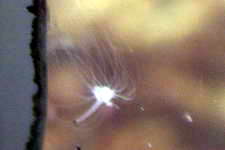


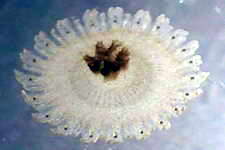
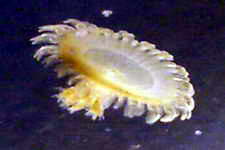

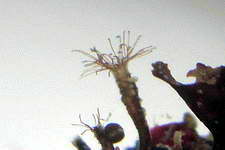
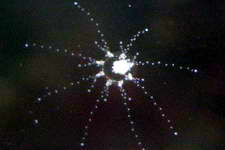
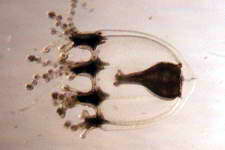
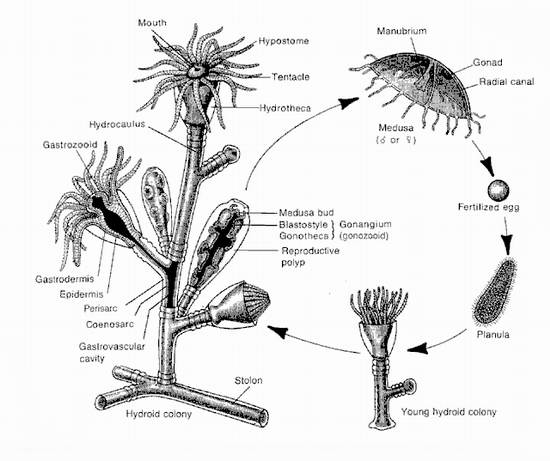

Below is a link that details how to construct a suitable tank to be able to correctly house a JellyFish, maybe in due time I will attempt this myself, Would make a great in wall tank.


Tank Raised Moon Jellyfish - An exellent "how to " article by Jim Stine
JellyFish for sale and display systems - For those not wishing to build one or wishing to actualy buy Jellyfish
Ode to a Jellyfish - Nice little article detailing our favorite little floating jellos.

From time to time, its not uncommon to find small species of jellyfish within our aquariums when we introduce live rock or use natural ocean water. I am sure I am not the only hobbyist who has found tiny jellys within their system and wondered at how they got there. Surprisingly, to me at least, they have a somewhat complicated life cycle and do not always appear as the jellys we are most familiar with.
In the reproductive life cycle of a typical jellyfish, males release sperm and females release eggs into the water. When an egg and sperm fuse to form a fertilized egg during sexual reproduction, a larva develops that attaches to a rock or other object and develops into a polyp. In a type of asexual reproduction, the polyp transforms into a colony of polyps that resembles a stack of saucers. Each saucer in the stack detaches itself from the colony as a new medusa, and the reproductive cycle repeats.

While the above graph is a typical reproductive cycle , there are species that each attached polyp forms a single young medusa as shown in the below series of photos that I documented within my own aquarium system.



An indivdual polyp
forming a single Cassiopeia species of jellyfish



Once completed, this
is what the juvenile jellyfish looks like when it detaches from the
polyp that formed it.



Another
species reproductive polyp and its resulting juvenile
jellyfish, which are often mistaken for hydroids


Hrdroid
Life Cycle
Hydroids are small, mostly colonial animals in the cnidarian Class Hydrozoa. These are simple animals. They are basicaly a sac consisting of an outside layer and inside layer with a "non-living" layer in between. They only have one opening into the digestive region, a "mouth" usually surrounded by tentacles. Consequently, undigested food has to be expelled out the mouth. Most of them are predatory, with a few species having zooxanthellae much like their coral cousins. The outer surface on the side opposite the mouth opening is either specialized to attach to a substrate (in polyps) or to swim (in medusae).
A major characteristic of the Cnidaria is the presence of nematocysts. In fact, the name Cnidaria came from the Greek " knide ," meaning "nettle," which refers to the stinging properties of the nematocysts. Often called "stinging cells," nematocysts are not cells at all, but are proteinaceous capsules secreted by specialized epithelial cells called cnidocytes. The capsule has a hyper-coiled internal thread that upon its release or having been "fired", penetrates the skin of the offending creature and injects its toxin(s).
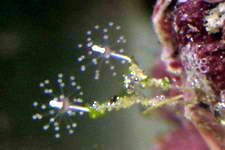
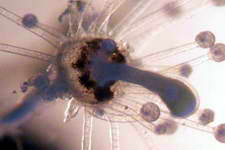

If not for their powerful stinging capability, I would want to keep a few species within my aquarium as I find them very interesting. The larger species can be quite stunning in appearance, yet unsuitable in a reef community setting. A species specific aquarium would however make for a very unique and interesting display. These are creatures that should be handled with care. They are quite capable of inflicting a very painfull sting, and normaly being in groups, multiple stings are usualy involved.
Hydroids are small, mostly colonial animals in the cnidarian Class Hydrozoa. These are simple animals. They are basicaly a sac consisting of an outside layer and inside layer with a "non-living" layer in between. They only have one opening into the digestive region, a "mouth" usually surrounded by tentacles. Consequently, undigested food has to be expelled out the mouth. Most of them are predatory, with a few species having zooxanthellae much like their coral cousins. The outer surface on the side opposite the mouth opening is either specialized to attach to a substrate (in polyps) or to swim (in medusae).
A major characteristic of the Cnidaria is the presence of nematocysts. In fact, the name Cnidaria came from the Greek " knide ," meaning "nettle," which refers to the stinging properties of the nematocysts. Often called "stinging cells," nematocysts are not cells at all, but are proteinaceous capsules secreted by specialized epithelial cells called cnidocytes. The capsule has a hyper-coiled internal thread that upon its release or having been "fired", penetrates the skin of the offending creature and injects its toxin(s).



If not for their powerful stinging capability, I would want to keep a few species within my aquarium as I find them very interesting. The larger species can be quite stunning in appearance, yet unsuitable in a reef community setting. A species specific aquarium would however make for a very unique and interesting display. These are creatures that should be handled with care. They are quite capable of inflicting a very painfull sting, and normaly being in groups, multiple stings are usualy involved.
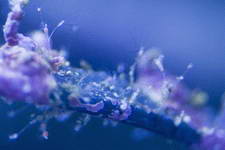
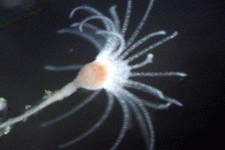
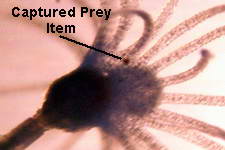
Typical hydroid species commonly found within our aquarium
systems.
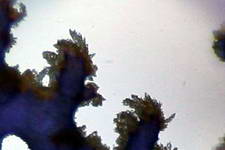
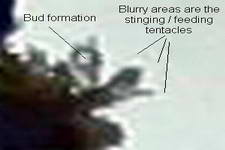
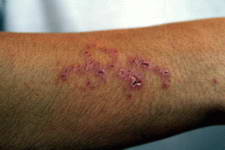
As with most hydroid species, they can quickly colonize any substrates,
including other life forms such as the macro algae shown above. As long
as the hydroids can get themselves up and out into water currents, they
are not very selective on what they grow upon. Should some of
the
more powerfull stinging species take up residence within your aquarium,
they can pose a real danger to you as well. As evident by the above
photo, this hobbyist merely brushed against the hydroids and came away
with some painfull wounds.




